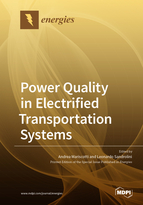Power Quality in Electrified Transportation Systems
A special issue of Energies (ISSN 1996-1073). This special issue belongs to the section "A1: Smart Grids and Microgrids".
Deadline for manuscript submissions: closed (25 July 2021) | Viewed by 43854
Special Issue Editors
Interests: EMC applied to industrial, military, and transportation systems; power quality and interference; power system modeling and analysis; electrical measurements, design, and construction of measurement setups and instrumentation; earthing, stray current, and lightning protection design
Special Issues, Collections and Topics in MDPI journals
Interests: electromagnetic compatibility
Special Issues, Collections and Topics in MDPI journals
Special Issue Information
Dear Colleagues,
Electrified transportation systems (from railways to metros, tramways, and other newer guideway systems) feature a variety of current distribution and collection systems, as well as an increasing use of power electronic conversion to support higher dynamics, better driving performance, and more efficient energy exploitation.
Static power conversion has known side effects caused by internal switching and transformation process: waveform distortion, harmonics and interharmonics, significant and varied reactive and nonactive power terms. The system architecture has grown in complexity, including solutions for energy storage and bidirectional exchange of energy with the utility, and an increased number of interacting control systems.
Standards and regulations for industrial applications extensively cover a variety of power quality phenomena and events, both steady-state and transient. The extension of standardization advancement to electric transports is not rapid and immediate for various reasons: among others, the peculiar current collection mechanism and the mechanical interface with the vehicles, the highly dynamic behavior of connected loads, and the interference mechanisms to signaling and communication systems (relevant to safety and availability).
A complex work is being developed in terms of analysis of network and load response (e.g., resonance and instability), interface and mutual influence with transmission and distribution at higher voltage, characterization of rolling stock as regards distortion patterns and input admittance (including analysis of nonlinearity and control), and methods and strategies to improve and compensate for power quality. The attainment of the investigations is particularly important since the bandwidth of onboard converters has increased, thus requiring a more cautious and comprehensive approach, but ensuring wider margins of control and optimization.
It would be beneficial to revisit the consolidated concepts of power quality in light of the new findings and research directions, to serve their purpose of quantifying the real impact in terms of distortion, instability, induction, losses, and aging of components of an electrified railway and of its vehicles.
This Special Issue has the aim of collecting contributions for this complex scenario, improving techniques of analysis, including modern converter architectures, fostering the definition of suitable power quality indices, and exploring suitable measurement methods and systems, with a constructive and open comparison of proposals, solutions, and experiences.
Original contributions including experimental results are expected. The topics of interest include but are not limited to:
- Analysis and modeling of harmonic emissions of rolling stock and converters, and interaction with the supply traction network;
- Characterization of novel traction supply architectures and power conversion apparatuses for Power Quality improvement, including solutions for power quality compensation;
- Definition and study of suitable power quality indices for electrified transports, covering not only more traditional phenomena, but also network instability, induction and interference with signaling and communication;
- Measurement methods and instrumentation, including realization of embedded systems and applications suitable for onboard and substation environment;
- Algorithms for data and signal analysis, such as spectral and statistical analysis, as well as correlation with operating conditions, network characteristics, and infrastructure.
Prof. Dr. Andrea Mariscotti
Prof. Dr. Leonardo Sandrolini
Guest Editors
Manuscript Submission Information
Manuscripts should be submitted online at www.mdpi.com by registering and logging in to this website. Once you are registered, click here to go to the submission form. Manuscripts can be submitted until the deadline. All submissions that pass pre-check are peer-reviewed. Accepted papers will be published continuously in the journal (as soon as accepted) and will be listed together on the special issue website. Research articles, review articles as well as short communications are invited. For planned papers, a title and short abstract (about 100 words) can be sent to the Editorial Office for announcement on this website.
Submitted manuscripts should not have been published previously, nor be under consideration for publication elsewhere (except conference proceedings papers). All manuscripts are thoroughly refereed through a single-blind peer-review process. A guide for authors and other relevant information for submission of manuscripts is available on the Instructions for Authors page. Energies is an international peer-reviewed open access semimonthly journal published by MDPI.
Please visit the Instructions for Authors page before submitting a manuscript. The Article Processing Charge (APC) for publication in this open access journal is 2600 CHF (Swiss Francs). Submitted papers should be well formatted and use good English. Authors may use MDPI's English editing service prior to publication or during author revisions.
Keywords
- Power quality
- Electrified railways
- Rapid transit system
- High-speed railways
- Train–network interaction
- Power converter
- Harmonic instability
- Harmonic resonance
- Network oscillation
- Spectrum analysis
- Harmonic analysis
- Measurement of electric quantities
- Voltage and current transducers







